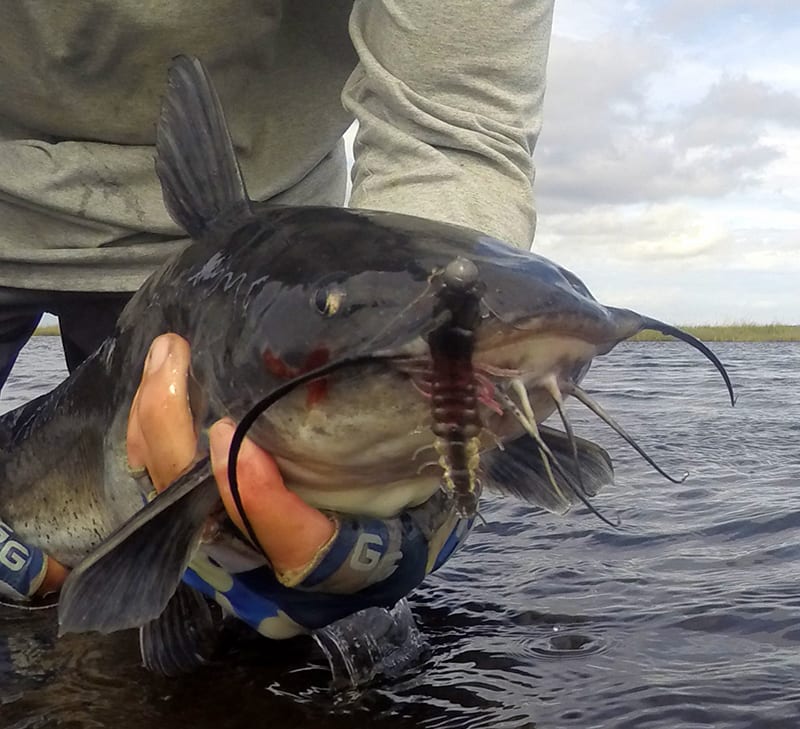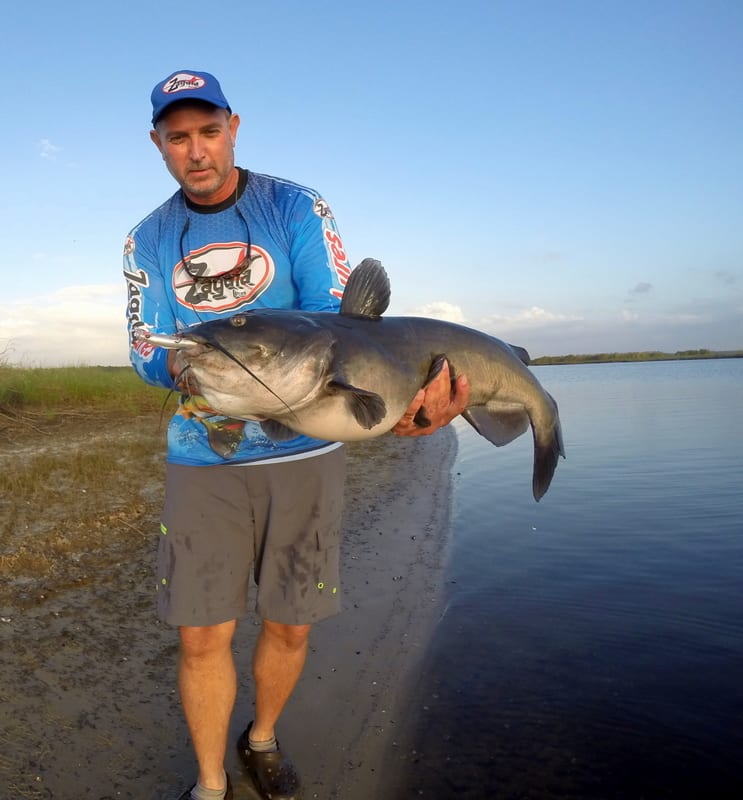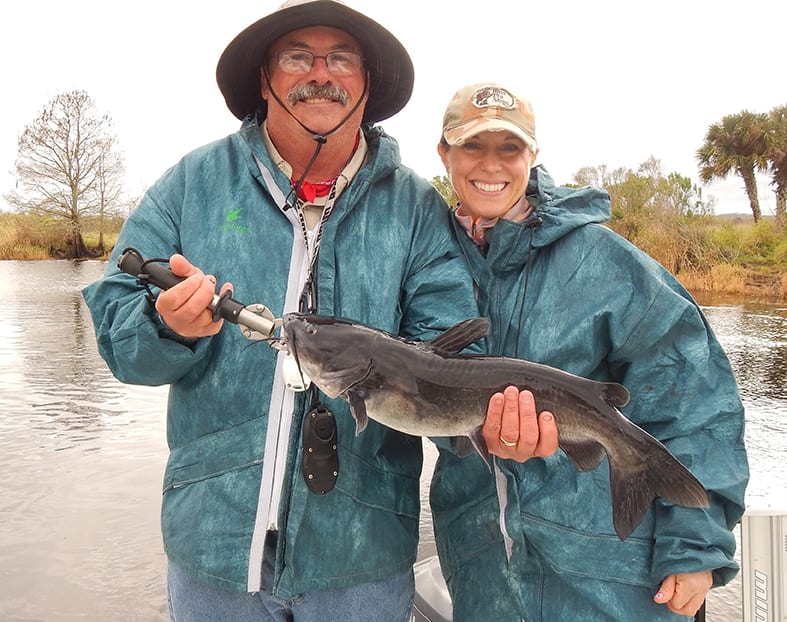Paul MacInnis
I never thought much about fishing for catfish in the St Johns River until I met Captain Tom Van Horn. Van Horn, a central Florida native, has spent a lifetime fishing for just about everything that swims in our waters. The numbers and size of catfish Van Horn catches definitely caught my attention.
According to FWC biologist Chad Owens, there are three species of catfish in the central St Johns, the channel, white and snail catfish, and three species of bullheads, brown, black and yellow. Most commonly caught in the central Florida stretch of the St Johns are channel cats and bullheads. Channels are the largest catfish in our local waters. The state record is 44 pounds. Channel catfish over 30 pounds have been pulled from the St Johns River. I’ve caught a handful over 20 pounds and several that weighed in the teens.
The nice thing about catfishing is you don’t need fancy baits or tackle. If you want to target bullheads and smaller pan-sized catfish you can use baits you gather right out of the river like grass shrimp and mussels. You can also use earth worms or small chunks of hotdog. Fish these baits on a 1/0 Aberdeen hook and add just enough split shot to your line to hold bottom.
I prefer to target bigger catfish, the bigger the better. Van Horn likes to use peeled shrimp for bait. You don’t need fresh shrimp, a bag of frozen shrimp from your local bait shop works fine. I also like to use cut bait as it holds up well to the bait stealers. Cut mullet or chunks from just about any fish work.
I use a standard fish finder rig. Run the line through a one-quarter to one ounce egg sinker, choosing just enough weight to hold bottom. Tie the line to a swivel and add about one to two feet of twenty pound test monofilament to the other end of the swivel. To the end of this leader I tie a 4/0 Team Catfish TC84Z circle hook.
Baitcasting gear used for bass fishing and 2000 to 3000 sized spinning tackle works fine for St Johns catfish. You can get by with inexpensive monofilament but I prefer a good quality ten pound test braid like Platypus Platinum Plus. Braid won’t bow out as much as monofilament due to wind or current so it gives you a straighter connection between rod tip and bait. This kind of tackle can get sporty if a ten pound plus catfish takes your bait, but sporty is exactly what I am looking for.
Popular wisdom says you should fish your baits in the deeper bends and holes in the river. I fished that way for years and caught plenty of one to five pound catfish, but bigger fish eluded me. The St Johns is loaded with little coves and basins branching out from the main river. I’ve learned if there is three feet or more of water in these basins there’s a decent chance there will be some nice catfish there. I’ll park my kayak at the edge of the opening and cast a bait towards the center of the mouth of the cove, trying to place my bait in the slack water but close, within ten feet or so, of the river current. If I am feeling ambitious I’ll toss a second bait towards the back of the cove. Most of the time the biggest catfish go for the bait close to the cove mouth but that isn’t always the case.
I like to let the circle hook do all the work so I’ll leave the rods in the rod holders until a fish puts a good bend in the rod and maybe even takes drag. Keep your ears open for loud splashes as channel cats will often thrash at the surface right after feeling the hook. Also watch your line. Catfish don’t always take the bait going away from you. If your line goes slack or your bait changes position reel up tight and see if there is a fish on the line. Finally, if you start catching a lot of bowfin you might want to move elsewhere (unless you like catching bowfin) because I find catfish and bowfin seldom share the same locations.
Channel catfish can be aggressive predators and many a bass angler has been surprised when a big cat grabs their bass lure. Most of the time I wouldn’t advise tossing lures as an efficient way of targeting catfish, but some years there is an exception that happens in spring into early summer. Winter and spring are central Florida’s dry season and water levels drop on the St Johns. Some years water levels get low enough that large stretches of the river seldom exceeded shin deep. Fish congregate in what deeper holes are left and become aggressive due to high competition for food. This is one time when you can readily catch catfish on lures and even flies. I like small plastic worms and other soft plastic baits bumped slowly along the bottom. Dark colors seem to work best and one lure that works particularly very well for me is the three inch Nikko Hellgrammite (https://nikko-fishing.com/product-category/hellgrammite/). Keep in mind catfish are primarily scent feeders so dousing your lure with a decent fish scent helps. I like Liquid Mayhem in the garlic minnow and shad scents. This is sticky stuff that stays on the lure for a long time.
During low water you’ll occasionally run across a real treat, a sandy bottom pool where you can spot catfish and sight cast to them. I highly recommend a quality pair of polarized sunglasses with an amber tint and mirror coating to help you tell catfish from gar and tilapia. I personally wear the Cruz-R from the Hobie Hydo Collection.
I suggest you give St Johns catfish a try, especially on those days when “gamefish” don’t cooperate. If you want to fish with an expert contact Captain Tom Van Horn (http://www.irl-fishing.com/).
By Paul MacInnis




